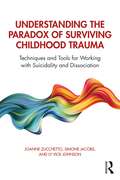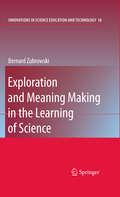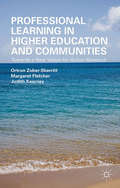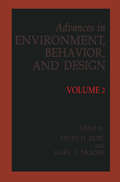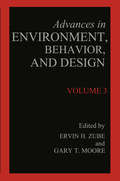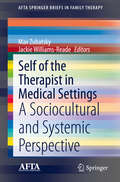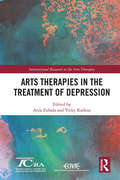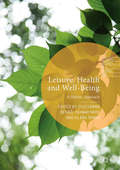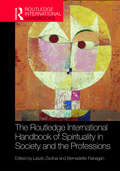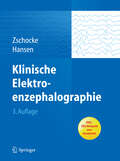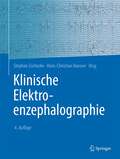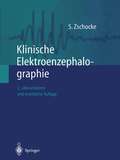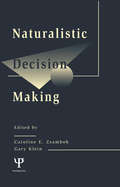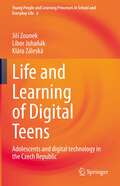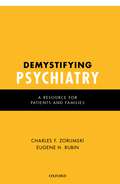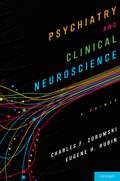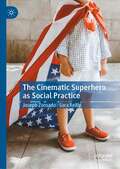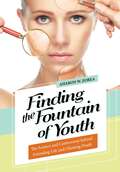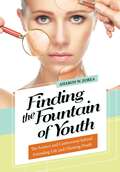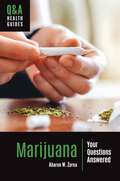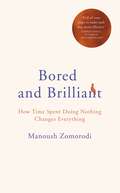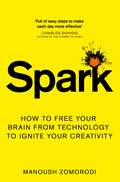- Table View
- List View
Understanding the Paradox of Surviving Childhood Trauma: Techniques and Tools for Working with Suicidality and Dissociation
by Joanne Zucchetto Simone Jacobs Ly Vick JohnsonUnderstanding the Paradox of Surviving Childhood Trauma offers clinicians a new framework for understanding the symptoms and coping mechanisms displayed by survivors of childhood abuse. This approach considers how characteristics such as suicidality, self-harm, persistent depression, and anxiety can have roots in behaviors and beliefs that helped patients survive their trauma. This book provides practitioners with case examples, practical tips, and techniques for applying this mindset directly to their most complex cases. By depathologizing patients’ experiences and behaviors, and moving beyond simply managing them, therapists can reduce their clients’ shame and work collaboratively to understand the underlying message that these behaviors conceal.
Exploration and Meaning Making in the Learning of Science (Innovations in Science Education and Technology #18)
by Bernard ZubrowskiMountaineers, Rock Climbers, and Science Educators Around the 1920s, rock climbing separated from mountaineering to become a separate sport. At that time European climbers developed new equipment and techniques, enabling them to ascend mountain faces and to climb rocks, which were considered unassailable up to that time. American climbers went further by expanding and improving on the equipment. They even developed a system of quantification where points were given for the degree of difficulty of an ascent. This system focused primarily on the pitch of the mountain, and it even calculated up to de- mals to give a high degree of quantification. Rock climbing became a technical system. Csikszentmihaly (1976) observed that the sole interest of rock climbers at that time was to climb the rock. Rock climbers were known to reach the top and not even glance around at the scenery. The focus was on reaching the top of the rock. In contrast, mountaineers saw the whole mountain as a single “unit of perc- tion. ” “The ascent (to them) is a gestalt including the aesthetic, historical, personal and physical sensations” (Csikszentmihaly, 1976, p. 486). This is an example of two contrasting approaches to the same kind of landscape and of two different groups of people. Interestingly, in the US, Europe, and Japan a large segment of the early rock climbers were young mathematicians and theoretical physicists, while the mountaineers were a more varied lot.
Professional Learning in Higher Education and Communities: Towards a New Vision for Action Research
by O. Zuber-Skerritt M. Fletcher J. KearneyBy integrating neuroscience and social science, this book introduces a bold new vision of Participatory Action Learning and Action Research (PALAR). The authors explain and enhance the art of action research through PALAR as a philosophy, methodology and theory of learning and as a facilitation process for professional learning and social justice.
Advances in Environment, Behavior and Design: Volume 2 (Advances in Environment, Behavior and Design #2)
by Erwin H. Zube Gary T. MooreThis second volume in the Advances in Environment, Behavior, and Design series follows the pattern of Volume 1. It is organized into six sections user group research, consisting of advances in theory, place research, sociobehavioral research, research and design methods, and research utilization. The authors of the chapters in this volume represent a range of disciplines, including architecture, geography, psychology, social ecology, and urban planning. They also offer international perspectives: Tommy Garling from Sweden, Graeme Hardie from South Africa (re cently relocated to North Carolina), Gerhard Kaminski from the Federal Republic of Germany, and Roderick Lawrence from Switzerland (for merly from Australia). Although most chapters address topics or issues that are likely to be familiar to readers (environmental perception and cognition, facility pro gramming, and environmental evaluation), four chapters address what the editors perceive to be new topics for environment, behavior, and design research. Herbert Schroeder reports on advances in research on urban for estry. For most of us the term forest probably conjures up visions of dense woodlands in rural or wild settings. Nevertheless, in many parts of the country, urban areas have higher densities of tree coverage than can be found in surrounding rural landscapes. Schroeder reviews re search that addresses the perceived and actual benefits and costs associ ated with these urban forests.
Advances in Environment, Behavior, and Design: Volume 3 (Advances in Environment, Behavior and Design #3)
by Erwin H. Zube Gary T. MooreThis third volume in Advances in Environment, Behavior, and Design fol lows the conceptual framework adopted in the previous two volumes (see the Preface to Volume 1, 1987). It is organized into five sections advances in theory, advances in place, user group, and sociobehavioral research, and advances in research utilization. The authors of this volume represent a wide spectrum of the multi disciplinary environment-behavior and design field including architec ture, environmental psychology, facility management, geography, human factors, sociology, and urban design. The volume offers interna tional perspectives from North America (Carole Despres from Canada, several authors from the U.S.), Europe (Martin Krampen from Germany, Martin Symes from England), and New Zealand (David Kernohan). More so than any of the previous volumes, they are drawn from both academia and professional practice. While there continues to be a continuity in format in the series, we are actively exploring new directions that are on the cutting edges of the field and bode well for a more integrated future. This volume will fur ther develop the themes of design and professional practice to comple ment the earlier emphases on theory, research, and methods.
Self of the Therapist in Medical Settings: A Sociocultural and Systemic Perspective (AFTA SpringerBriefs in Family Therapy)
by Max Zubatsky Jackie Williams-ReadeThis brief explores how the “person” of the therapist is developed when training and working in medical settings. It highlights important and often unspoken topics such as the personal, professional, cultural, ethical, and competency dilemmas new clinicians regularly face. The brief also addresses how personal experience with illness, death, cultural differences, and stigma may impact professionals in everyday practice. Topics featured in this Brief include:Helpful tips and tricks for new professionals entering a medical setting for the first time.Working with patients who suffer from chronic and terminal illnesses.Sociocultural norms and values that are often present in a medical setting.A new framework for identifying and treating professional burnout.How to handle ethical situations in medical organizations. Self of the Therapist in Medical Settings is a must-have resource for clinicians, professionals, supervisors, and faculty working in medical settings.
Arts Therapies in the Treatment of Depression (International Research in the Arts Therapies)
by Ania Zubala Vicky KarkouArts Therapies in the Treatment of Depression is a comprehensive compilation of expert knowledge on arts therapies’ potential in successfully addressing depression. The book identifies ways of addressing the condition in therapy sessions, shares experience of tools and approaches which seem to work best and guides towards a conscious and confident evidence-based practice. Including contributions from international experts in the field of arts therapies, the book presents some of the most recent, high-profile and methodologically diverse research, whether in the form of clinical trials, surveys or case studies. The three sections of this volume correspond to particular life stages and explore major topics in arts therapies practice and the nature of depression in children, adults and in later life. Individual chapters within the three sections represent all four arts therapies disciplines. The book hopes to improve existing arts therapies practice and research, by encouraging researchers to use creativity in designing meaningful research projects and empowering practitioners to use evidence creatively for the benefit of their clients and the discipline. Arts Therapies in the Treatment of Depression is an essential resource for arts therapies researchers, practitioners and arts therapists in training. It should also be of interest to other health researchers and health professionals, particularly those who work with clients experiencing depression and in multidisciplinary teams.
Arts Therapies in the Treatment of Depression (International Research in the Arts Therapies)
by Ania Zubala Vicky KarkouArts Therapies in the Treatment of Depression is a comprehensive compilation of expert knowledge on arts therapies’ potential in successfully addressing depression. The book identifies ways of addressing the condition in therapy sessions, shares experience of tools and approaches which seem to work best and guides towards a conscious and confident evidence-based practice. Including contributions from international experts in the field of arts therapies, the book presents some of the most recent, high-profile and methodologically diverse research, whether in the form of clinical trials, surveys or case studies. The three sections of this volume correspond to particular life stages and explore major topics in arts therapies practice and the nature of depression in children, adults and in later life. Individual chapters within the three sections represent all four arts therapies disciplines. The book hopes to improve existing arts therapies practice and research, by encouraging researchers to use creativity in designing meaningful research projects and empowering practitioners to use evidence creatively for the benefit of their clients and the discipline. Arts Therapies in the Treatment of Depression is an essential resource for arts therapies researchers, practitioners and arts therapists in training. It should also be of interest to other health researchers and health professionals, particularly those who work with clients experiencing depression and in multidisciplinary teams.
Leisure, Health and Well-Being: A Holistic Approach (Leisure Studies in a Global Era)
by Zsuzsanna Benkő, Ishwar Modi and Klára TarkóThis book explores health and leisure as a holistic phenomenon with individual and social dimensions. Contributors to this edited volume explore the physical, mental, emotional, sexual and social aspects of health and leisure as well as the influence of moral and religious principles. The connections between the individual and the social structure, social integration, the social division of labor, and the natural environment are also analysed.The volume studies this relationship from a range of disciplinary backgrounds, including sociology, psychology, psychiatry, medical sciences, sport sciences, education, policy making, and from both national and international perspectives. As such, the collection will be of interest to scholars and students across a range of disciplines, including Leisure Studies, Health Studies, Health Promotion, Psychology and Mental Health, Sociology and Sport Studies.
The Routledge International Handbook of Spirituality in Society and the Professions (Routledge International Handbooks)
by Laszlo Zsolnai Bernadette FlanaganIncreasingly, it is being recognized that spirituality, defined here as "a multiform search for a transcendent meaning of life that connects them to all living beings and brings them in touch with God or ‘Ultimate Reality,’" is an aspect of almost every sphere and aspect of social life. It appears in humanity’s dealings with nature, home and community, healing, economics and business, knowledge, and education. The Routledge International Handbook of Spirituality in Society and the Professions is a stimulating collection that summarizes the most important issues, frameworks, discussions, and problems relating to spiritually inspired activities in different fields of social life. The contributors explore how spirituality is a part of existence and present approaches and models for professionals working in diverse areas. Presented in seven parts, the book provides a full overview of current research and practice. Part II, "Facets of spirituality," explores topics including philosophy, psychology, theology, and culture. Part III, "Nature," looks at ecology, agriculture, cities, and tourism. Part IV, "Home and community," presents chapters on various life stages, disability, gender, and culture. Part V, "Healing," examines medicine, mental and physical health, and ill-health. In Part VI, "Economy, politics, and law," contributors discuss business, leadership and the workplace, peace, and policing. Part VII, "Knowledge and education," includes chapters on science, design, fashion, literature, and the arts. In the final part, "Way forward," the editors look to the future with a chapter on inter-spirituality and the renewal of social practices. Driven by contemporary research and new developments, this Handbook is an innovative and interdisciplinary collection that provides an essential overview of contemporary spirituality and society from an international selection of contributors. The Routledge International Handbook of Spirituality in Society and the Professions offers accessible, diverse, and engaging international research, and its scope will appeal to academics and students of a wide range of subjects, including aging and addiction, psychology, theology, religious studies, sociology, business studies, and philosophy. It will also be an important work for professionals in medical and social services, the clergy, education, business, the arts, religious communities, and politics, and members of organizations looking at the links between spirituality, religion, and society.
The Routledge International Handbook of Spirituality in Society and the Professions (Routledge International Handbooks)
by Laszlo Zsolnai Bernadette FlanaganIncreasingly, it is being recognized that spirituality, defined here as "a multiform search for a transcendent meaning of life that connects them to all living beings and brings them in touch with God or ‘Ultimate Reality,’" is an aspect of almost every sphere and aspect of social life. It appears in humanity’s dealings with nature, home and community, healing, economics and business, knowledge, and education. The Routledge International Handbook of Spirituality in Society and the Professions is a stimulating collection that summarizes the most important issues, frameworks, discussions, and problems relating to spiritually inspired activities in different fields of social life. The contributors explore how spirituality is a part of existence and present approaches and models for professionals working in diverse areas. Presented in seven parts, the book provides a full overview of current research and practice. Part II, "Facets of spirituality," explores topics including philosophy, psychology, theology, and culture. Part III, "Nature," looks at ecology, agriculture, cities, and tourism. Part IV, "Home and community," presents chapters on various life stages, disability, gender, and culture. Part V, "Healing," examines medicine, mental and physical health, and ill-health. In Part VI, "Economy, politics, and law," contributors discuss business, leadership and the workplace, peace, and policing. Part VII, "Knowledge and education," includes chapters on science, design, fashion, literature, and the arts. In the final part, "Way forward," the editors look to the future with a chapter on inter-spirituality and the renewal of social practices. Driven by contemporary research and new developments, this Handbook is an innovative and interdisciplinary collection that provides an essential overview of contemporary spirituality and society from an international selection of contributors. The Routledge International Handbook of Spirituality in Society and the Professions offers accessible, diverse, and engaging international research, and its scope will appeal to academics and students of a wide range of subjects, including aging and addiction, psychology, theology, religious studies, sociology, business studies, and philosophy. It will also be an important work for professionals in medical and social services, the clergy, education, business, the arts, religious communities, and politics, and members of organizations looking at the links between spirituality, religion, and society.
Klinische Elektroenzephalographie
by Stephan Zschocke Hans-Christian HansenDie Autoren beschreiben in dem Band die physiologischen und pathophysiologischen Grundlagen der Elektroenzephalographie (EEG) und machen die Technologie Schritt für Schritt verständlich: Behandelt werden die EEG-Potenziale in ihren verschiedenen Formen sowie der Einsatz der EEG in der Intensivmedizin. Das Werk hilft Ärzten, brauchbare Kurven zu gewinnen, Befunde zu verstehen und zu interpretieren, aber auch Fehler zu vermeiden. Die 3., aktualisierte und überarbeitete Auflage enthält ein neues Kapitel über die EEG in der Neuropädiatrie.
Klinische Elektroenzephalographie
by Stephan Zschocke Hans-Christian HansenDie Autoren beschreiben in dem Band die physiologischen und pathophysiologischen Grundlagen der Elektroenzephalographie (EEG) und machen die Technologie Schritt für Schritt verständlich: Behandelt werden die EEG-Potenziale in ihren verschiedenen Formen sowie der Einsatz der EEG in der Intensivmedizin. Das Werk hilft Ärzten, brauchbare Kurven zu gewinnen, Befunde zu verstehen und zu interpretieren, aber auch Fehler zu vermeiden. Die 3., aktualisierte und überarbeitete Auflage enthält ein neues Kapitel über die EEG in der Neuropädiatrie.
Naturalistic Decision Making (Expertise: Research and Applications Series)
by Caroline E. Zsambok Gary KleinIf you aren't using the term naturalistic decision making, or NDM, you soon will be. Even as a very young field, NDM has already had far-reaching applications in areas as diverse as management, aviation, health care, nuclear power, military command and control, corporate teamwork, and manufacturing. Put simply, NDM is the way people use their experience to make decisions in the context of a job or task. Of particular interest to NDM researchers are the effects of high-stake consequences, shifting goals, incomplete information, time pressure, uncertainty, and other conditions that are present in most of today's work places and that add to the complexity of decision making. Applications of NDM research findings target decision aids and training that help people in their decision-making processes. This book reports the findings of top NDM researchers, as well as many of their current applications. In addition, the book offers a historical perspective on the emergence of this new paradigm, describes recent theoretical and methodological advancements, and points to future developments. It was written for people interested in decision making research and applications relative to a diverse array of work settings and products such as human-computer interfaces, decision support systems, individual and team training, product designs, and organizational development and planning.
Naturalistic Decision Making (Expertise: Research and Applications Series)
by Caroline E. Zsambok Gary KleinIf you aren't using the term naturalistic decision making, or NDM, you soon will be. Even as a very young field, NDM has already had far-reaching applications in areas as diverse as management, aviation, health care, nuclear power, military command and control, corporate teamwork, and manufacturing. Put simply, NDM is the way people use their experience to make decisions in the context of a job or task. Of particular interest to NDM researchers are the effects of high-stake consequences, shifting goals, incomplete information, time pressure, uncertainty, and other conditions that are present in most of today's work places and that add to the complexity of decision making. Applications of NDM research findings target decision aids and training that help people in their decision-making processes. This book reports the findings of top NDM researchers, as well as many of their current applications. In addition, the book offers a historical perspective on the emergence of this new paradigm, describes recent theoretical and methodological advancements, and points to future developments. It was written for people interested in decision making research and applications relative to a diverse array of work settings and products such as human-computer interfaces, decision support systems, individual and team training, product designs, and organizational development and planning.
Life and Learning of Digital Teens: Adolescents and digital technology in the Czech Republic (Young People and Learning Processes in School and Everyday Life #6)
by Jiří Zounek Libor Juhaňák Klára ZáleskáThis book describes and explains how digital technologies enter adolescents’ everyday life and learning in different contexts and environments. The book is based on research conducted in recent years in the Czech Republic, the results of which are set within a broad theoretical and international framework.The authors consider the theoretical and methodological anchoring of the topic, describing various approaches in an effort to comprehensively describe and understand the learning process of today’s pupils. They focus on ways to explore learning in the digital era, domestication of digital technology in families, and parents' approaches to digital technology. Attention is paid to adolescents’ competences and autonomy in the use of digital technologies, as well as their views on technology in their lives and learning. The authors summarize the most important results of the research, but also consider the options of empirical research and their own experience with the research of such a complex concept.
Demystifying Psychiatry: A Resource for Patients and Families
by Charles F. Zorumski, MD Eugene Rubin, MD, PhDPsychiatry is arguably the most misunderstood specialty in modern medicine and psychiatrists are often thought of as part physician, part confessor, part police officer, and part shaman. In Demystifying Psychiatry, two eminent psychiatrists offer an illuminating look at the entire field, offering a clear and informative portrait of a medical specialty often clouded in myth. Zorumski and Rubin range from a basic discussion of what psychiatry is, to the types of illnesses psychiatrists treat, the training of psychiatrists, the treatment of psychiatric disorders (covering medications, psychotherapy, lifestyle interventions, electroconvulsive therapy, and much more), and how families can help with treatment. They caution the consumer about practices that should raise red flags. The book also covers new trends in psychiatry and explores the future of the field, predicting that major advances in genetics and neuroscience will lead to rapid and amazing changes in psychiatry. The book concludes with extensive reference materials that will be valuable both to general readers and medical practitioners.
Psychiatry and Clinical Neuroscience
by Charles Zorumski Eugene RubinPsychiatric disorders are brain disorders, reflecting dysfunction within and across neural networks. Advances in functional neuroimaging and cellular neuroscience offer hope of revolutionizing the approach to diagnosis and treatment of mental illnesses. This resource presents an introduction to network neuroscience and demonstrates the relationship of advances in this field to the future of psychiatry. Oxford Clinical Neuroscience is a comprehensive, cross-searchable collection of resources offering quick and easy access to eleven of Oxford University Press's prestigious neuroscience texts. Joining Oxford Medicine Online these resources offer students, specialists and clinical researchers the best quality content in an easy-to-access format.
The Cinematic Superhero as Social Practice
by Joseph Zornado Sara ReillyThis book analyzes the cinematic superhero as social practice. The study’s critical context brings together psychoanalysis and restorative and reflective nostalgia as a way of understanding the ideological function of superhero fantasy. It explores the origins of cinematic superhero fantasy from antecedents in myth and religion, to twentieth-century comic book, to the cinematic breakthrough with Superman (1978). The authors then focus on Spider-Man as reflective response to Superman’s restorative nostalgia, and read MCU’s overarching narrative from Iron Man to End Game in terms of the concurrent social, political, and environmental conditions as a world in crisis. Zornado and Reilly take up Wonder Woman and Black Panther as self-conscious attempts to reflect on gender and race in restorative superhero fantasy, and explore Christopher Nolan’s Dark Knight trilogy as a meditation on the need for authoritarian fascism. The book concludes with Logan, Wonder Woman 1984, and Amazon Prime’s The Boys as distinctly reflective fantasy narratives critical of the superhero fantasy phenomenon.
Finding the Fountain of Youth: The Science and Controversy behind Extending Life and Cheating Death
by Aharon W. ZoreaSeparating truth from hype, this book introduces readers to the topic of life extension in a holistic manner that provides scientific, historical, and cultural perspectives.While the story of 16th-century explorer Juan Ponce de León futilely searching for the Fountain of Youth is likely a myth, it is true that for many centuries, mankind has sought "a cure for aging." Today, the anti-aging and longevity industry is a multibillion-dollar industry, and medical advances are continuing to find ways to add to our time on earth. Finding the Fountain of Youth: The Science and Controversy behind Extending Life and Cheating Death introduces readers to the topic of life extension in a holistic manner, examining the topic through scientific, historical, and cultural perspectives. It also highlights key medical and ethical controversies related to this particular area of gerontology and serves as a gateway for further research and study.The book's chapters address the history of movements to remain youthful, from ancient times through the modern era; past medical advances that significantly extended the average lifespan; and our cultural obsession with "staying young" that has spawned the anti-aging industry. Readers will learn about basic principles of aging and anti-aging, as well as the science behind the methods—both proven and hypothetical—that serve to extend the lifespan. The final section of the book examines controversial issues and debates related to life extension, such as global overpopulation, length of life versus quality of life, and socioeconomic concerns.
Finding the Fountain of Youth: The Science and Controversy behind Extending Life and Cheating Death
by Aharon W. ZoreaSeparating truth from hype, this book introduces readers to the topic of life extension in a holistic manner that provides scientific, historical, and cultural perspectives.While the story of 16th-century explorer Juan Ponce de León futilely searching for the Fountain of Youth is likely a myth, it is true that for many centuries, mankind has sought "a cure for aging." Today, the anti-aging and longevity industry is a multibillion-dollar industry, and medical advances are continuing to find ways to add to our time on earth. Finding the Fountain of Youth: The Science and Controversy behind Extending Life and Cheating Death introduces readers to the topic of life extension in a holistic manner, examining the topic through scientific, historical, and cultural perspectives. It also highlights key medical and ethical controversies related to this particular area of gerontology and serves as a gateway for further research and study.The book's chapters address the history of movements to remain youthful, from ancient times through the modern era; past medical advances that significantly extended the average lifespan; and our cultural obsession with "staying young" that has spawned the anti-aging industry. Readers will learn about basic principles of aging and anti-aging, as well as the science behind the methods—both proven and hypothetical—that serve to extend the lifespan. The final section of the book examines controversial issues and debates related to life extension, such as global overpopulation, length of life versus quality of life, and socioeconomic concerns.
Marijuana: Your Questions Answered (Q&A Health Guides)
by Aharon W. ZoreaThis book explores marijuana from a variety of angles, including its impacts on the brain and body, potential for abuse, and legal status. Relying on science rather than sensationalism, it answers young readers' most pressing questions about this controversial drug.In 2022, medical marijuana is legal in 37 states and recreational marijuana is legal in 18, yet the drug remains illegal at the federal level. Public opinion on marijuana has changed substantially in the last 20 years, and today many young people view the drug as benign or even beneficial. But how exactly does marijuana affect the body and mind, and what are the potential risks of abuse or addiction?Books in Greenwood's Q&A Health Guides series follow a reader-friendly question-and-answer format that anticipates readers' needs and concerns. Prevalent myths and misconceptions are identified and dispelled, and a collection of case studies illustrate key concepts and issues through relatable stories and insightful recommendations. Each book also includes a section on health literacy, equipping teens and young adults with practical tools and strategies for finding, evaluating, and using credible sources of health information both on and off the internet—important skills that contribute to a lifetime of healthy decision-making.
Bored and Brilliant: How Time Spent Doing Nothing Changes Everything
by Manoush Zomorodi'Bored and Brilliant is full of easy steps to make each day more effective' Charles Duhigg, author of The Power of HabitIt’s time to move ‘doing nothing’ to the top of your to-do list Have you ever noticed how you have your best ideas when doing the dishes or staring out the window? It's because when your body goes on autopilot, your brain gets busy connecting ideas and solving problems.However in the modern world it often feels as though we have completely removed boredom from our lives; we are addicted to our phones, we reply to our emails twenty-four hours a day, tweet as we watch TV, watch TV as we commute, check Facebook as we walk and Instagram while we eat. Constant stimulation has become our default mode. In this easy to follow, practical book, award-winning journalist Manoush Zomorodi explores the connection between boredom and original thinking, and will show you how to ditch your screens and start embracing time spent doing nothing. Bored and Brilliant will help you unlock the way to becoming your most productive and creative self.
Spark: How to free your brain from technology to ignite your creativity
by Manoush Zomorodi'Crammed with practical exercises for anyone who wants to reclaim the power of spacing out' - Gretchen Rubin, author of #1 New York Times Bestseller The Happiness ProjectIt’s time to move ‘doing nothing’ to the top of your to-do list Have you ever noticed how you have your best ideas when doing the dishes or staring out the window? It's because when your body goes on autopilot, your brain gets busy connecting ideas and solving problems.However in the modern world it often feels as though we have completely removed boredom from our lives; we are addicted to our phones, we reply to our emails twenty-four hours a day, tweet as we watch TV, watch TV as we commute, check Facebook as we walk and Instagram while we eat. Constant stimulation has become our default mode. In this easy to follow, practical book, award-winning journalist Manoush Zomorodi explores the connection between boredom and original thinking, and will show you how to ditch your screens and start embracing time spent doing nothing. Spark will help you unlock the way to becoming your most productive and creative self.'Full of easy steps to make each day more effective' Charles Duhigg, author of The Power of Habit*Spark was previously published as Bored and Brilliant.*
